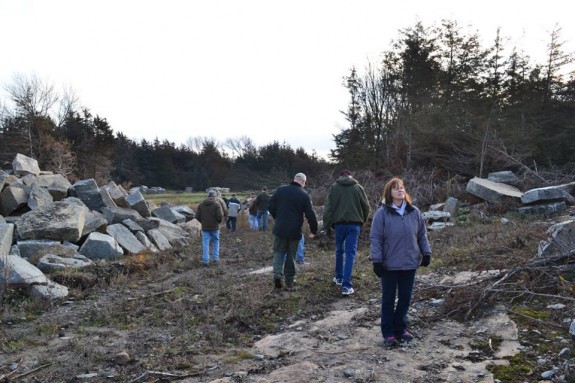CURE rallies citizens to support neighbors opposed to new mining along MN River
In August, CURE received a call from a landowner in Sacred Heart South Township, Renville County. He was one of four residents notified by the Renville County Board of Adjustment and Appeals that a public hearing had been scheduled to consider a variance request to re-open a Duininck Inc. gravel mine. The proposed site is adjacent to the residents’ properties. The parcel of land under consideration is less than 20 acres, is surrounded by Conservation Reserve Enhancement Program (CREP) land, and is located in the Minnesota River floodplain. It is located just north of the Minnesota River.
Although aggregate mining can impact a broad spectrum of the community, only four nearby landowners were notified of the public hearing. In an effort to open the process to public review, CURE tapped into our network and worked to spread the word about the hearing. On August 27th, several CURE members including CURE board members were present and testified to the impact this mining operation would have on the ecology and environmental integrity of the surrounding area. For now, the Conditional Use Permit needed to open the mine was denied.
More residents seek help to protect critical habitat
In mid-November, CURE received another call about a Conditional Use Permit (CUP) request by Mankato-based Kasota Stone Fabricator to open a quarry pit near Belview, MN. CURE met with the concerned adjacent landowner to provide support and strategy for the public hearings scheduled in both Yellow Medicine and Redwood counties.
On November 17th, members of CURE’s board and staff testified on the impact that extracting granite from this site would have on the ecology and environmental integrity of the surrounding area. Several landowners in attendance expressed concerns over noise, truck traffic, water usage, water quality, dust, safety, signage and wells. That evening, the Yellow Medicine County Planning Commission voted 5 to 3 to deny the CUP. It was noted in the Granite Falls Advocate Tribune that a denial of a CUP is a rare occurrence in Yellow Medicine County.
This permitting is complicated by the fact that approximately 80 percent of the mining site is in Yellow Medicine County and the other 20 percent is in Redwood County. Landowners must appeal to both counties.

On November 23rd, Kasota invited board members from Redwood County and landowners to tour the site. CURE toured the proposed mining site at the invitation of the landowners and saw first-hand where the mining would occur. This site is just south of the Minnesota River in the heart of pristine wetlands and granite outcrops and several of the wetland potholes tier and drain directly into the river.

Less than a quarter of a mile from this quarry site is a conservation wetland restored in the late 80’s. The wetland project was a joint effort of the Minnesota Water Fowl Association, Minnesota Ducks Unlimited, the Minnesota Department of Natural Resources, and the Soil, Water and Conservation District of Redwood County with the help of the Huseby and Lecy families. A dam was installed to create a wetland habitat that supports a wide variety of wildlife, and the rare 5-lined skink has documented sightings in the area.
What is special about this property and makes it paramount that it remain protected is that it is nestled in a location that is otherwise surrounded by miles and miles of conventional row-crop farmland. There are few of these pristine locations left that are protected by private landowners.

CURE’s support of transparency and democratic process is a critical public service
More and more often, landowners are at a loss when trying to figure out where to go when confronted by threats to their land and quality of life.
Minnesota is one of a few states that have land use ordinances at the county and, in some cases, the township level, that give landowners rights beyond simply a nuisance claim. This fall, CURE has been the go-to organization that citizens in the Minnesota River Valley to ask for help. CURE has been approached about a poorly located ATV Recreational Park, the ever-increasing large-scale dairy and hog operations, aggregate mining, and the challenges that come when one tries to restore a natural wetland.

Landowners are often at a loss when they are notified about a public hearing. Often, they only have two weeks to prepare for a hearing, while the applicant for the permit has been working with local administrators on the request for months. There are few resources available to assist landowners on how to navigate the process. One might think the first step might be to call an attorney, but Minnesota has a shortage of attorneys that specialize in this area and then to find one without a conflict who is willing to take your case is even more of a challenge.
Thank you to those citizens who have taken an active role in the democratic process to protect the critical habitat and quality of life for the people and wildlife that call the Minnesota River Valley home.
Blog post and photos by Peg Furshong, Director of Operations & Constituent Relations and Events & Adventures Program Coordinator.

